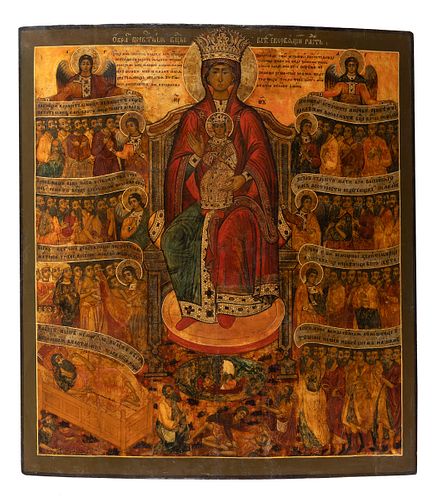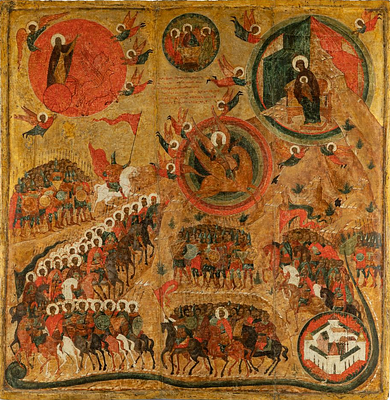Russian school, workshops of the Old Believers, 17th century. "The Virgin of All Sorrows". Tempera, gold leaf on panel.
Lot 16
About Seller
Setdart Auction House
Carrer Aragó 346
Barcelona
Spain
Setdart Subastas was born in 2004 and is currently the first online art auction in Spain with solidity, prestige and reliability guaranteed by our more than 60,000 users. Setdart has a young, dynamic and enterprising team ready to successfully manage the purchase and sale of art works through custom...Read more
Estimate:
EUR€10,000 - EUR€12,000
$10,752.69 - $12,903.23
Absentee vs Live bid
Two ways to bid:
- Leave a max absentee bid and the platform will bid on your behalf up to your maximum bid during the live auction.
- Bid live during the auction and your bids will be submitted real-time to the auctioneer.
Bid Increments
| Price | Bid Increment |
|---|---|
| EUR€0 | EUR€10 |
| EUR€200 | EUR€25 |
| EUR€500 | EUR€50 |
| EUR€1,000 | EUR€100 |
| EUR€3,000 | EUR€200 |
| EUR€5,000 | EUR€500 |
| EUR€10,000 | EUR€1,000 |
| EUR€20,000 | EUR€2,000 |
| EUR€50,000 | EUR€5,000 |
About Auction
By Setdart Auction House
Sep 23, 2021
Set Reminder
2021-09-23 10:00:00
2021-09-23 10:00:00
America/New_York
Bidsquare
Bidsquare : RUSSIAN ICONS
https://www.bidsquare.com/auctions/setdart-auction-house/russian-icons-7431
Setdart Auction House sofia@setdart.com
Setdart Auction House sofia@setdart.com
- Lot Description
Russian school, workshops of the Old Believers, 17th century. "The Virgin of All Sorrows". Tempera, gold leaf on panel. Measurements: 110 x 98 cm. The Virgin of All Sorrows is a type of Marian iconography venerated in the orthodox Russian church, and it is considered miraculous. The canon appeared in 1688 in Moscow in the Church of the Virgin of All Sorrows, also known as the Church of the Transfiguration, although other earlier versions are known, but with different iconography. The final typology of the icon was formed in Russia under a strong Western influence. It is possible to perceive similarities with the iconography of Misericordia, of the Immaculate Conception or Maestà. The icon presented for auction is a real find of Orthodox religious painting. The typology of the faces, the hieratic nature of the seated Virgin, the use of colour and the minimal contrast between light and shade indicate that we are dealing with a truly ancient icon, painted towards the end of the 17th century, just at the time when this Marian representation became popular. The very large size of the icon, 110 by 98 centimetres, indicates that it is most likely that the icon was made for ecclesiastical use, as small icons were usually commissioned for domestic use. This spectacular icon corresponds to the traditional canon, albeit with slight modifications. It should be noted that this typology of Marian icons allows for variations within the canon, and some historians even agree that the icon of "The Virgin of All Sorrows" lacks a canon as such, due to these variations. Be that as it may, the present canonical icon depicts the Mother of God seated hieratically on the throne, which is the centre of attention in the icon, both because of its central location and its size. She is surrounded by four segments which in turn contain a horror vacui of various people afflicted by illness and pain. The throne is framed by a series of angels, protectors of the Virgin. They are turned towards the sick, as if they were saying the prayers to them, inscribed on the bands that divide the segments. The overall emotion of the icon is full of sorrow, love and hope, and reaches its maximum drama in the outer register, in the central scene and on the left. There we find the scenes, with the river Styx, and with the people lying down or semi-bent over, which directly allude to the theme of death. But they are all looking at the seated Virgin, symbolising her adoration. The Icon of Interest is the masterpiece of orthodox religious painting, because within the hieratic and somewhat static character of the figures, it is incredibly dynamic due to the invisible lines created by the gazes and eyes. It has rhythm, created by the repetitive and compound elements in a pattern, such as the nimbuses of the angels or the borders with the inscriptions. Its decorative richness and the master's attention to detail make this icon an unforgettable piece, which could be considered museum level.
- Shipping Info
-
In-house shipping available. Please inquire at admin@setdart.com.
-
- Buyer's Premium



 EUR
EUR CAD
CAD AUD
AUD GBP
GBP MXN
MXN HKD
HKD CNY
CNY MYR
MYR SEK
SEK SGD
SGD CHF
CHF THB
THB
















